Amazon sword (Echinodorus grisebachii) would be a great addition to most freshwater planted aquariums. Being versatile and easy to plant, grow, and maintain, you can’t go wrong.
I love how green and vibrant it gets in my tanks. However, it does get very big, so it doesn’t suit every tank.
To help you figure out if it’s right for you, this guide will teach you everything you need to know to properly care for amazon swords in your aquarium.
Quick Stats Care Overview
- Scientific Name: Echinodorus grisebachii/ Echinodorus amazonicus
- Family: Alismataceae
- Order: Alismatales
- Genus: Echinodorus
- Care Level: Easy
- Growth Rate: Moderate
- Maximum Size: 12-20 Inches (30-50 cm)
- Water Conditions: 60.8-82.4°F (20-27°C), 6.5-7.5 pH, 8-15 dGH
- Lighting: Medium to High (PAR 50-80)
- Tank Placement: Mid-ground
Table of Contents
Amazon Sword (Echinodorus grisebachii) Overview
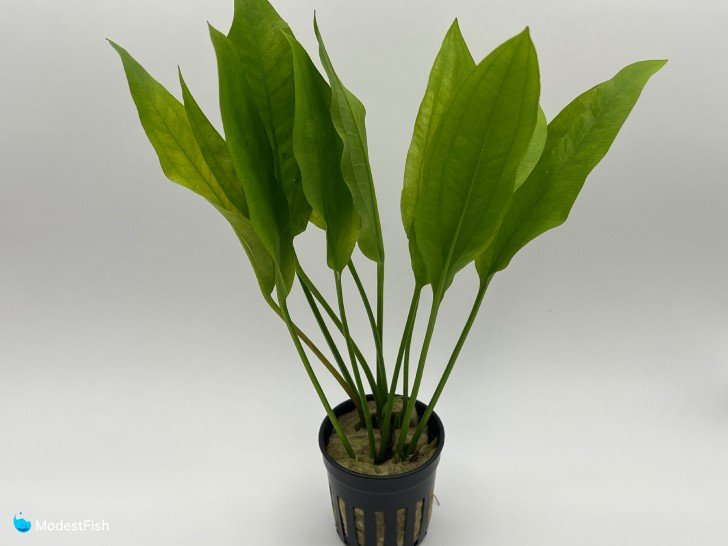
The Amazon Sword plant is a freshwater aquatic plant that can grow when partially or fully submerged in water. It originates in countries around the Amazon River basin, such as Cuba, Brazil, and Bolivia.
It’s sold in stores nowadays for placement in aquariums and ponds. The “Amazon Sword” label could belong to either one of two species; Echinodorus grisebachii or Echinodorus amazonicus.
The two species basically look the same, with minor differences in the width of the leaves, where the Echinodorus amazonicus has narrower ones.
Amazon swords are heavy root feeders and have extensive root systems which require a nutritious substrate (or inert with root tabs). They have long, deep green sword-shaped leaves (hence the name). The leaves typically measure 16 inches (40 cm) on average, but they can reach 20 inches and even larger.
It is very easy to care for and grow in your aquarium, I’ve had success with it for years. And it plays an excellent role in providing natural shade and spawning grounds for fish. Angelfish and discus especially like to lay their eggs along the leaves.
Caring for Amazon Sword In Your Aquarium
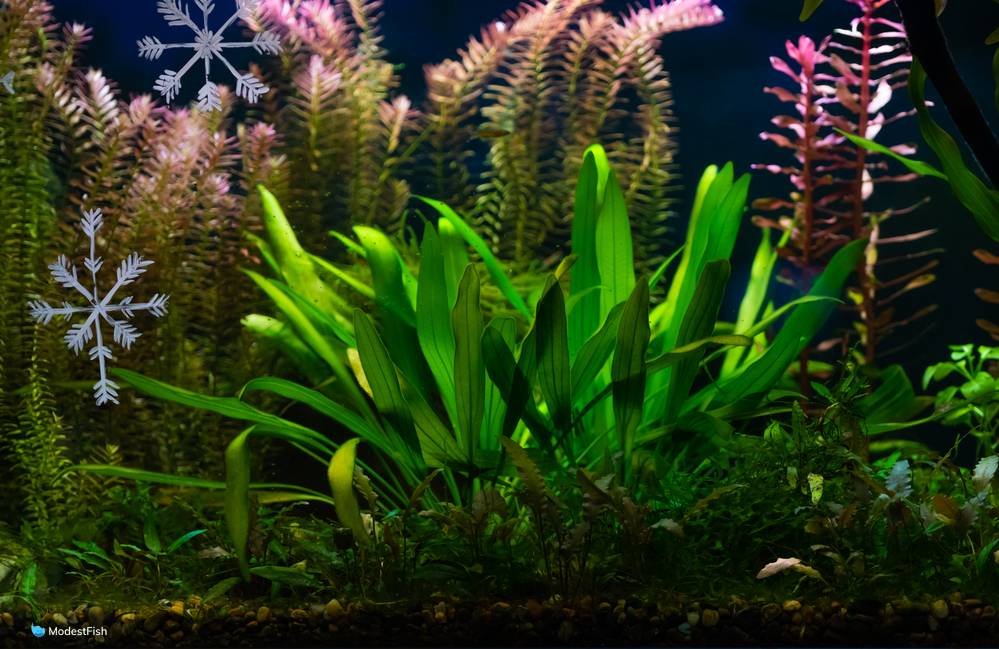
Tank Size
It’s possible to keep amazon swords in a 10-gallon or 20-gallon tank, but I really wouldn’t recommend it. You want to make sure the tank is more than 14 inches tall, but really 16 would be much better. I guess the minimum I would recommend would be a 29 gallon tall, but even then you risk the plant taking over.
Personally, I’ve only kept amazon swords in 40 and 55 gallon tanks. This plant can grow up to 18 inches tall and wide, sometimes even bigger. That’ll completely take over a small tank. Unless, that’s the look you want to go for.
Water Parameters
- Temperature: A temperature similar to that of tropical waters is preferred from 60.8 to 82.4°F. (ideally from 68 to 75°F)
- pH: The closer to neutral, the better, so stay in the 6.5–7.5 range. (can go as low as 6)
- dGH: Slightly to moderately hard water is preferred because any softer and the plant may get mineral deficiencies, so stay in the 8-15 range. But they can do fine in most water.
Amazon swords can adapt to a wide range of parameters, so your best bet is to just aim to keep parameters stable instead of seeking a number.
Lighting Conditions
Amazon swords can live at low to medium light (Around PAR 50) levels. But, it’ll also do very well with higher light (above PAR 80). 6-8 hours should be enough.
I’ve found it’s always done well around 50PAR (medium lighting), and using a customizable LED light is the easiest way to maintain a consistent light schedule.
Substrate & Fertilizers
Amazon swords are heavy root feeders and grow extensive root systems. This means you’ll either need to use 2-3 inches of aqua soil, dirted tank with a sand cap, or an inert substrate (sand or gravel), with root tabs around the base of the plant.
You’ll have success growing amazon swords with any of those 3 options. Just pick which one you like the most.
In my experience, I’ve grown huge amazon swords in just regular gravel and inert sand. These tanks were heavily stocks, so the root systems were able to feed off fish waste that worked its way into the substrate.
A weekly dose of an all-in-one liquid fertilizer like Seachem Excel will also aid health and growth. CO2 is not required, but it will grow better with it added. But, it’s not worth the expense in my opinion.
Maintenance
Trimming is a great way to ensure new growth has a chance to develop, you can trim the largest overgrown leaves. You also want to trim any damaged or browning leaves.
To do this you want to carefully separate the stem as close as possible from the root. I do this by gripping the stem and using my thumb to push the base downwards into the substrate. This will detach the stem at the root and the downwards motion will ensure you don’t pull up any roots.
But, make sure there is new leaf growth before you go trimming off all the leaves.
How To Plant Amazon Sword
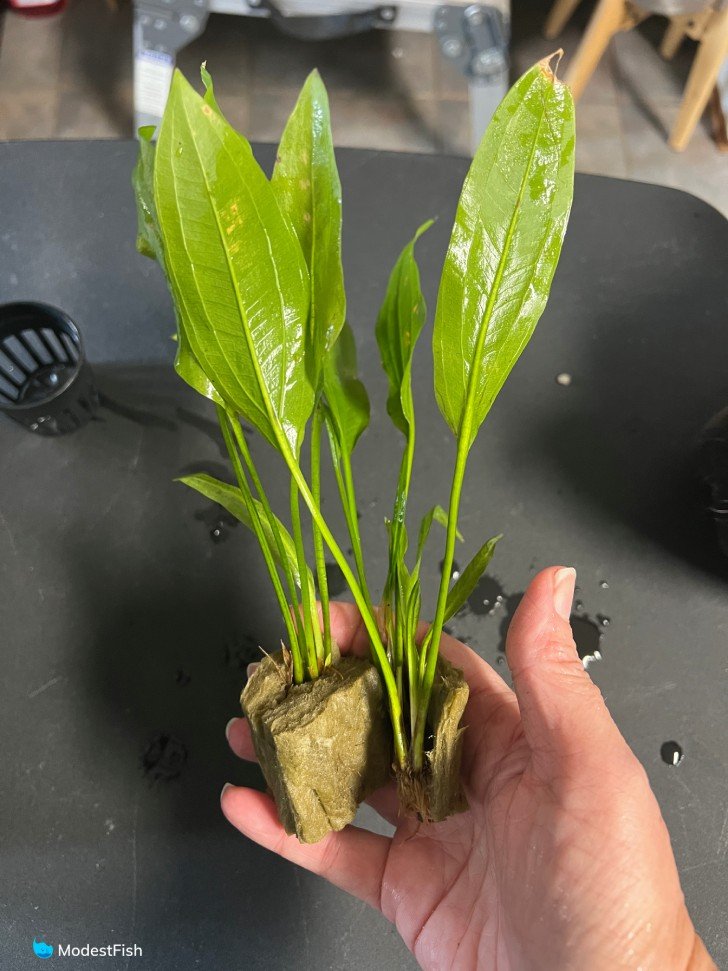
There isn’t much to planting an Amazon sword. You simply push it deep enough to bury the whole root but leave the stem of the baby plant exposed. This ensures that the plant has enough space to fully extend its leaves and roots, as both can get quite large and extensive.
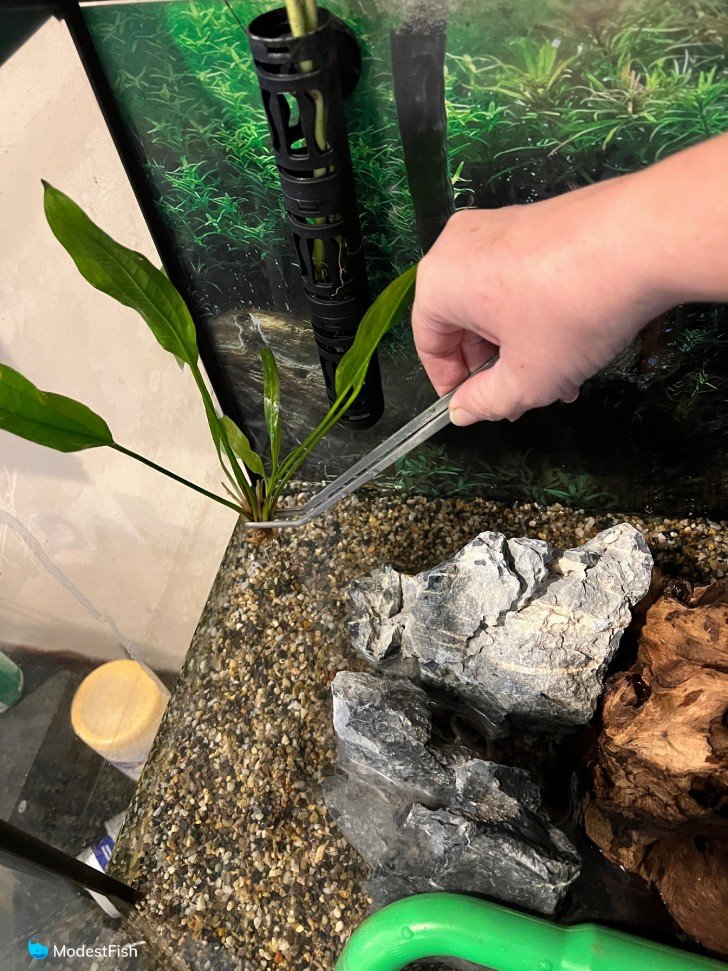
Pro Tip: using aquascaping tweezers can make planting in substrate much smoother.
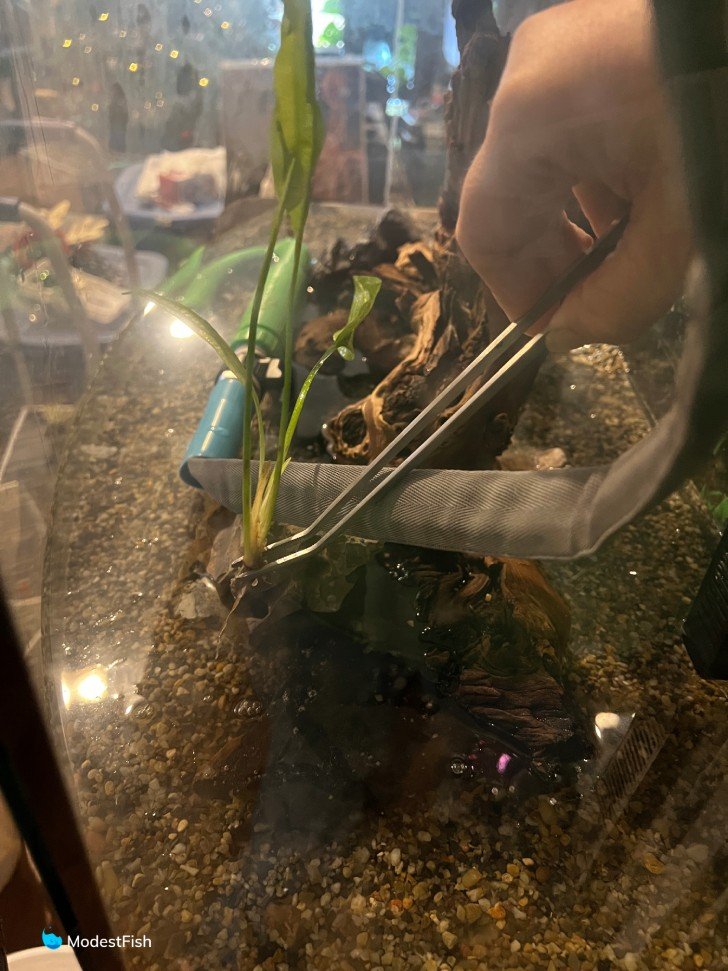
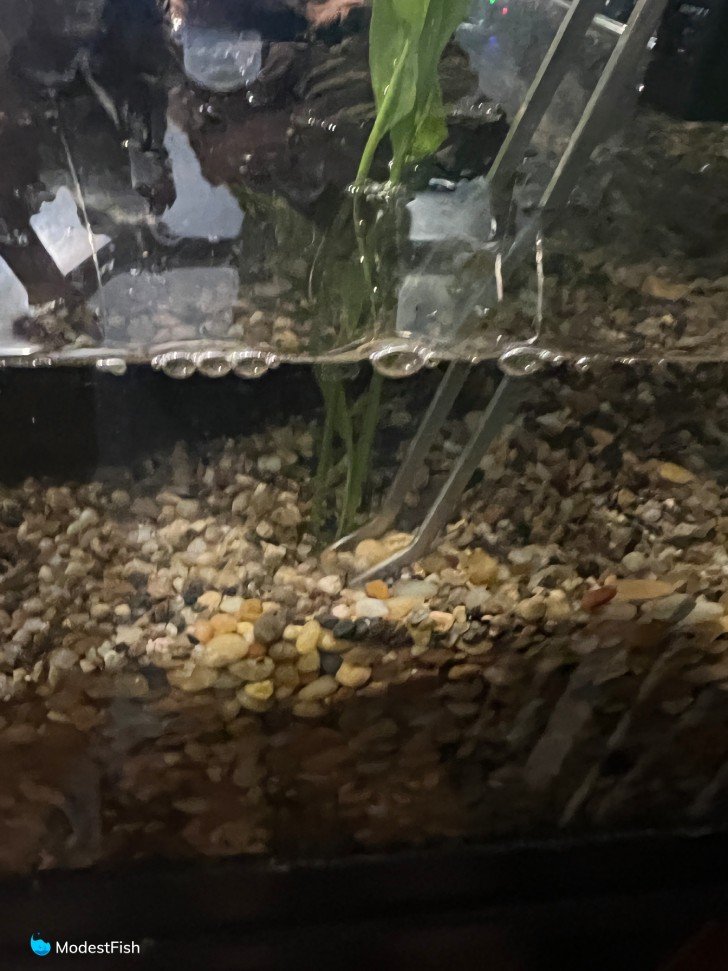
Another option is to plant them in terracotta pots. Amazon swords can grow very elaborate root systems, and if you want to move it, you may risk digging up a bunch of your substrate. This can be really annoying if you’re a tinkerer.
Putting some aqua soil or inert substrate with some root tabs in a terracotta pot is a good way to provide the roots with nutrients, whilst maintaining flexibility.
How to Propagate Amazon Sword

The propagation of an Amazon Sword Plant is quite simple. The plant’s main stem develops multiple offshoots, called runners, every 3-4 inches. These runners look like stems but produce no leaves. They grow into small plants -that can sometimes be a little yellowish- having their own tiny roots and stems.
Once the roots increase in size and number, the new plants can be cut and planted in their new home, whether it’s the same tank or a new one. Easy.
How to Use Amazon Sword in an Aquarium
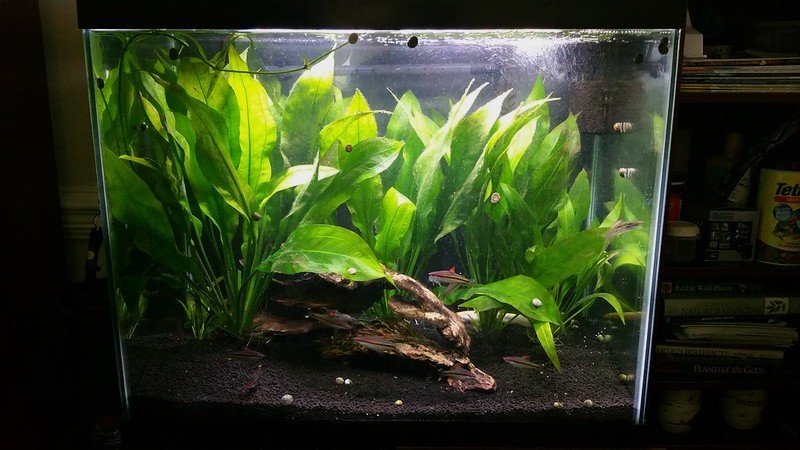
An Amazon Sword plant is usually placed mid-ground, aka at the center of the tank, where it acts as a statement piece around which the rest of your tank components are set up, whether they’re other plants, caves, rocks, etc.
It can also be placed in the background with others of its kind, where the bushy leaves grow and intermingle, giving rise to a jungle-like effect.
Just remember, wherever you plant it, it’ll dominate that space. So keeping some plants like anubias close by can be great as they do well in the shade and won’t compete for nutrients from the substrate.
No matter how or where you place it, it offers multiple benefits. Other than its appearance, it acts as a source of nutrition and a hideout for fish.
It also rids the water or harmful nitrates and toxins, keeping the water clean. You can even hide a heater or filter tube behind its leaves, making your tank more aesthetically pleasing.
Tank Mates for Amazon Sword
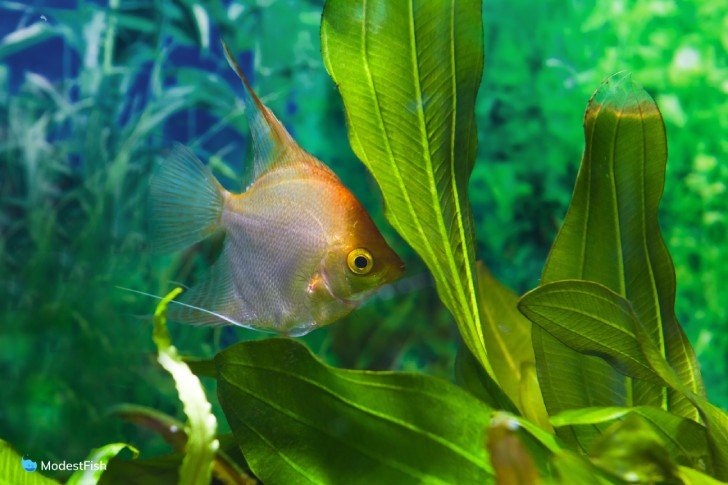
There are numerous options suitable as a tank mate for this plant, whether it’s aquatic creatures like fish or different plant types.
As for fish, you should choose fish with a mild temperament that won’t roughen up your plant and damage their leaves. Guppies, Gouramis, Platies, Tetras, and Angelfish are some of the suitable choices.
On the other hand, steer clear of Oscars, Goldfish, large cichlids, and in particular, Plecos. If you don’t want your plant to be riddled with bite marks, then you could choose bottom-dwellers like shrimps, otos, and snails. They’ll leave your plant intact and eat the algae on it instead.
Amazon Sword Leaves Turning Yellow, Cracking, & Tearing
Due to the delicate nature of the plant, it’s quite common to find its leaves yellowing, cracking, and even tearing.
However, there are a few things you can do to prevent or fix these problems. If your newly planted Amazon Sword leaves start turning yellow and dying, simply trim the dead leaves, and new healthy leaves will grow once the plant has acclimated to the tank.
This is because it’s common for the plant you buy to have been grown out of the water (emersed). That’s why when you put a new plant in your tank, it can melt back. So if it’s a new plant, just be patient as the plant is shedding its emersed leaves and will regrow immersed leaves (under water).
As long as you have new growth in the center, your plant is healthy.
On the other hand, if an already established plant starts yellowing, then this is due to poor water conditions or a lack of nutrients. So, clean your water and readjust its parameters. Also, add an iron-rich fertilizer or root tabs for extra measure.
Unfortunately, the plant can’t repair its cracked or torn leaves, so the best thing you can do is cut the damaged leaves off. This allows the plant to redirect its energy towards maintaining healthy leaves and growing new ones.
Amazon Sword Right For Your Tank?
With minimal care, the Amazon Sword plant can grow to be a beautiful addition to your tank. It’s appropriate for community fish tanks and very easy to plant and propagate.
As long as you’re going to have a large tank 40 gallon plus, maybe a 29 tall, this plant can make a great centerpiece. It’s a classic and beautiful plant everyone should own at least once, but needs a large tank long-term.
